Local Control
Environmental Organizing on Giving Day 2020

TUESDAY GIVING DAY UPDATE:
We’re over half-way to our goal of $10,000.
Please help us get there today.
1. Today the Communities Foundation of Texas is sponsoring a special COVID crisis North Texas Giving Day for DFW non-profits.
2. The Peace Development Fund has chosen to spotlight the COVID-connected work of Downwinders and 12 other groups across the country to help during the crisis.
The Fund and generous donors are matching every dollar we raise this week up to $10,000 – that’s a $20,00,000 grant on the line.
We have until Friday to raise the $10,000.
You can help us reach this goal right now by contributing at our North Texas Giving Day Page or the Mighty Cause pay portal the Development Fund has set up for us.
Thanks for your support,


Evelyn Mayo, Chair
____________________________________
COVID Connects:
Community Organizing to
Environmental Health
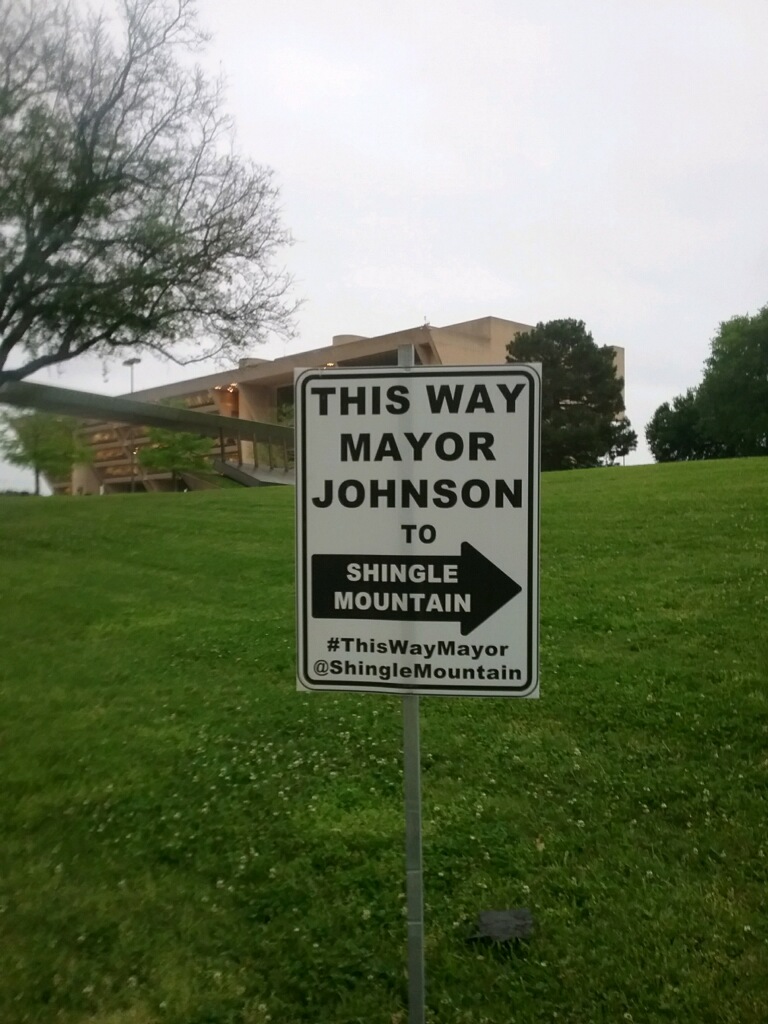 200 signs like these went up across Dallas on Earth Day 2020. Major Johnson has yet to visit or speak publicly about the highest profile environmental justice scandal since the West Dallas RSR lead smelter Superfund site 25 years ago.
200 signs like these went up across Dallas on Earth Day 2020. Major Johnson has yet to visit or speak publicly about the highest profile environmental justice scandal since the West Dallas RSR lead smelter Superfund site 25 years ago.
What is It?
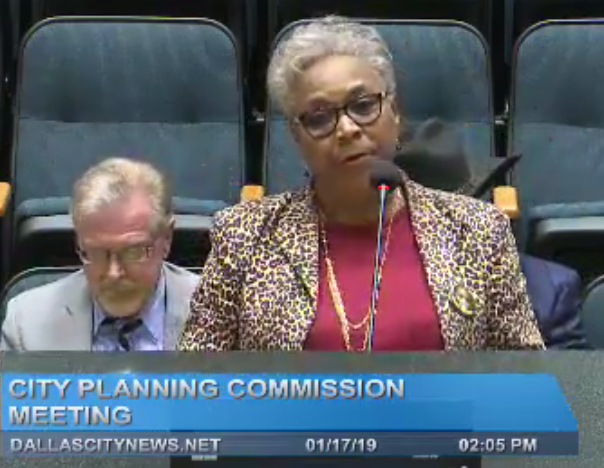 Downwinders provides much needed basic organizing resources to local grassroots environmental health fights.We offer the only full time staff devoted to applying community organizing principles to assist groups. We provide start-up funding for fliers and other materials. We’re the only citizens group that has the technology to take air pollution samples…and the classes to teach you how to do it as well. Mostly, we give those in need the attention they’re not getting from officials or anyone else.
Downwinders provides much needed basic organizing resources to local grassroots environmental health fights.We offer the only full time staff devoted to applying community organizing principles to assist groups. We provide start-up funding for fliers and other materials. We’re the only citizens group that has the technology to take air pollution samples…and the classes to teach you how to do it as well. Mostly, we give those in need the attention they’re not getting from officials or anyone else.
Most importantly, we show how to use a fight to change the system that produced the problem. The most recent example is the Shingle Mountain illegal dump and the group Southern Sector Rising that was created to shut it down and clean it up.
Why Do It?
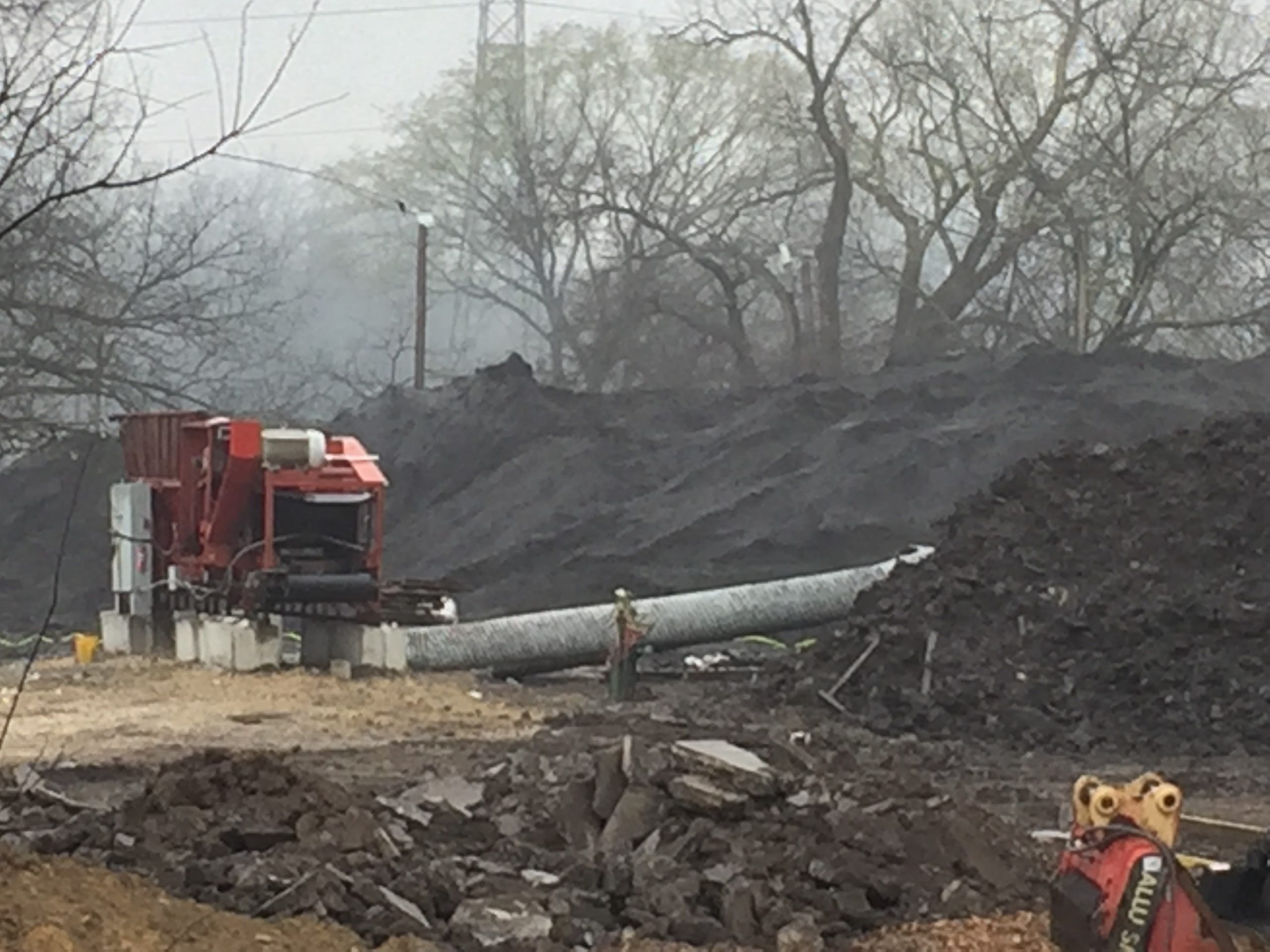 Shingle Mountain for almost a year when she finally found Downwinders. It took us only three months of organizing with Ms. Jackson to get the City to reverse itself and file suit against the site’s operators to close the site.Out of that effort sprang Southern Sector Rising, a group aimed at not only seeking justice for Shingle Mountain residents but making sure Dallas implemented a citywide Environmental Justice agenda. Part of that agenda, announced on March 20th 2019 at a City Hall news conference, was the restoration of the Dallas Environmental Health Commission and a Environmental Equity Provision that would steer polluters away from already over-polluted neighborhoods.
Shingle Mountain for almost a year when she finally found Downwinders. It took us only three months of organizing with Ms. Jackson to get the City to reverse itself and file suit against the site’s operators to close the site.Out of that effort sprang Southern Sector Rising, a group aimed at not only seeking justice for Shingle Mountain residents but making sure Dallas implemented a citywide Environmental Justice agenda. Part of that agenda, announced on March 20th 2019 at a City Hall news conference, was the restoration of the Dallas Environmental Health Commission and a Environmental Equity Provision that would steer polluters away from already over-polluted neighborhoods.
Southern Sector Rising and Downwinders are using the example of Shingle Mountain to pass policies aimed at preventing new Shingle Mountains.
What’s the COVID Connection?
In 2020 it seems obvious that municipal governments need to address environmental health issues. But Dallas ditched it’s original Environmental Health Commission a decade ago.
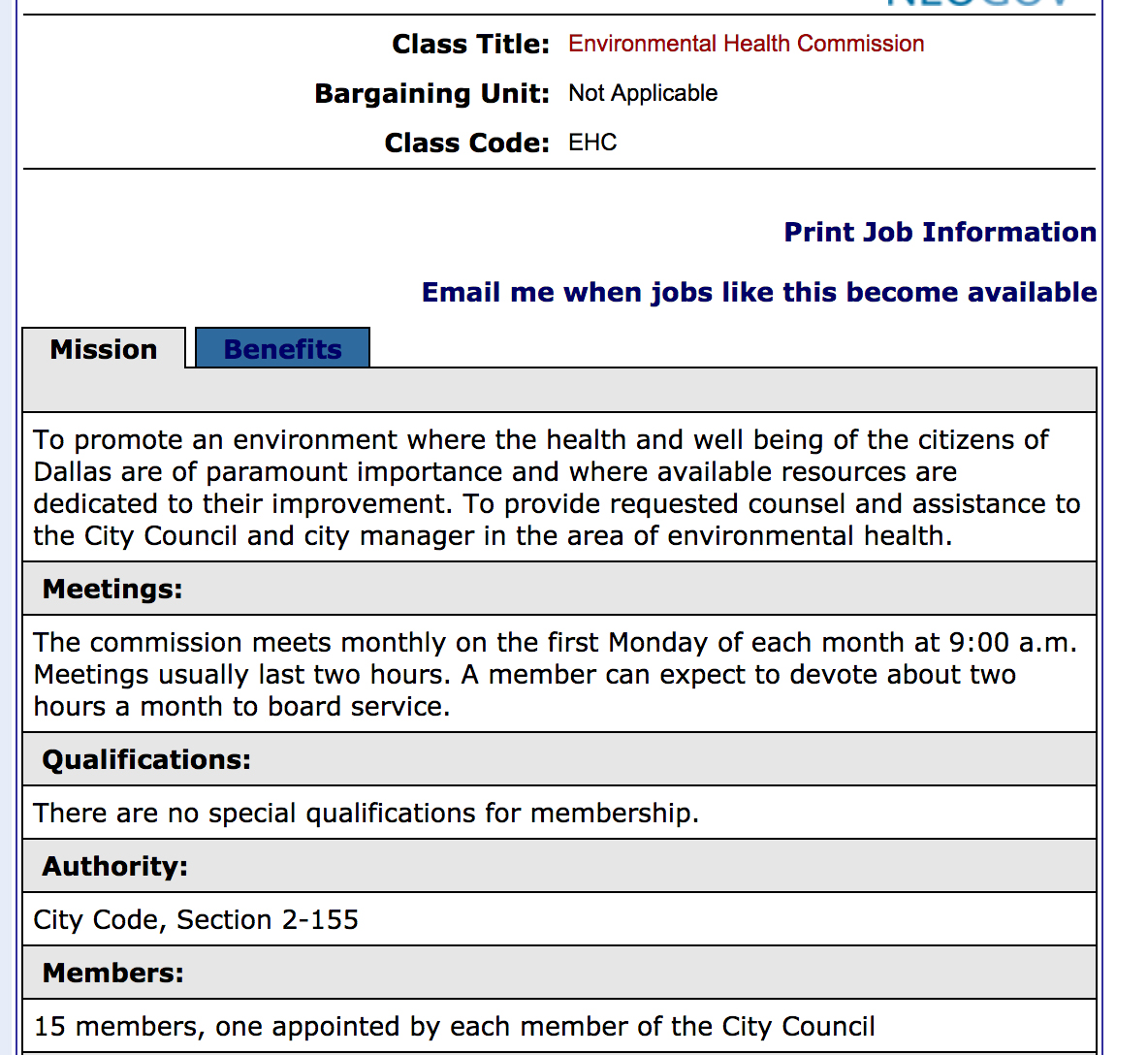 Formed in the wake of the 1980’s West Dallas and East Oak Cliff Lead smelter fights, the Health Commission was a citizen-based watchdog. It recommended the effective banning of hazardous and medical waste incineration in the City and wrote a tough anti-smoking policy before the Council disbanded it.
Formed in the wake of the 1980’s West Dallas and East Oak Cliff Lead smelter fights, the Health Commission was a citizen-based watchdog. It recommended the effective banning of hazardous and medical waste incineration in the City and wrote a tough anti-smoking policy before the Council disbanded it.
Had the Commission been around in 2017, it’s likely the Shingle Mountain dump would have shown-up on Dallas City Hall’s radar screens a lot sooner than it did when a reporter had to tell officials about the outrage a year later.
And an “equitable” economic development policy would end the practice of illegal dumpers and grifters targeting Southern Dallas for their schemes. That pattern of “development” is one reason why residents find themselves more vulnerable to COVID.
Before the virus, City Hall policy avoided environmental health issues. This pandemic shows why it must embrace and plan for them.
STATUS?
Southern Sector Rising has asked that restoration of the Dallas Environmental Health Commission be part of the City’s new climate plan, up for a vote on May 27th. Despite 10 of the current 15 Dallas City Council members having endorsed the idea only last Spring, there’s been no public movement toward adoption. 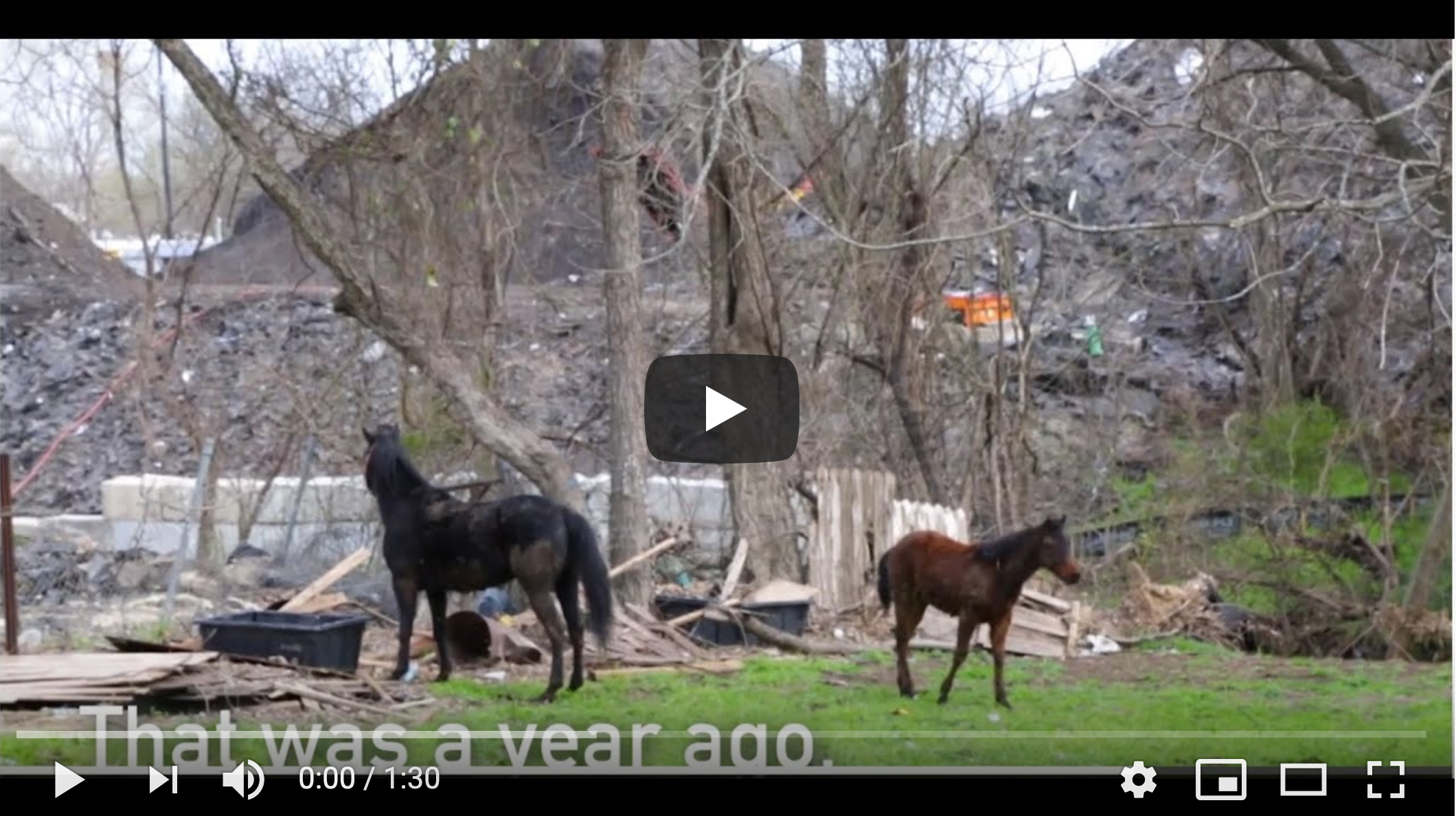
SSR won the closing of Shingle Mountain as an active operation, but the dump itself remains an on-going public health crisis in its own right. Over 100,000 tons of petroleum based asphalt shingles
are stacked 6-7 stories high next door to Dallas residents, including families with children.
Despite being invited and holding office for a year, Dallas Mayor Eric Johnson has never visited or commented publicly on Shingle Mountain.
over 200 “directional aids” went up around
ACTION YOU CAN TAKE:
Here’s a link to a quick “ClickNSend” letter you can send Dallas Mayor Eric Johnson to help him find his way to Shingle Mountain
COVID CONNECTIONS
Downwinders At Risk was already dedicated to fighting for environmental health in North Texas before the COVID virus hit.
Focusing on harmful Particulate Matter, we were already supporting grassroots efforts to reduce the air pollution burdens in predominantly Black and Brown neighborhoods.
We were already building out local capacity to monitor DFW air pollution and advocating an increased role for local cities and counties to protect their residents from environmental health threats.
All of that work was important before March. It’s become more important since then. But our responsibilities on the ground are outstripping our ability to support them adequately. Like other non-profits, the virus has made it harder to do even the simple things.
This week you can help provide some relief.
The Peace Development Fund has chosen to spotlight the COVID-connected work Downwinders is doing, along with that of 12 other grassroots groups across the country to help supplement their budgets during the crisis. The Fund and generous donors are matching every dollar we raise this week up to $10,000 – that’s a $20,00,000 grant on the line.
We have until Friday to raise the $10,000.
Beginning today and continuing thru Tuesday the 5th at Midnight you can help us meet this goal by contributing via our North Texas Giving Day Page.
Then Wednesday thru Friday the Development Fund has its own Downwinders Mighty Cause pay portal you can also use.
We’re using each day this week to show how our various pieces of program work is more relevant than ever before. Today it’s an update on our ambitious new DFW air monitoring network – SHAREDAIRSDFW.
We know everyone is having a hard time, but with the Development Fund matching your dollars, you can make whatever contribution you give go twice as far to benefit those at highest risk.
Thanks for your support,


Evelyn Mayo, Chair
COVID Connects:
Vulnerable Communities to the Need
for Better Air Pollution Monitoring
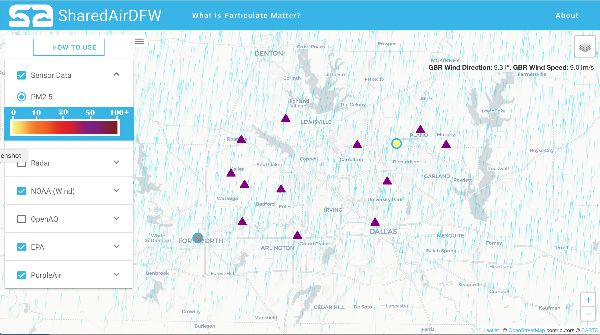
A screenshot of the SHAREDAIRDFW network map being assembled by UTD students and Downwinders at Risk. This map will soon be available at websites hosted by UTD, Dallas County and Downwinders, Only two of the over 100 new monitors are installed (dots) but more are on their way.
What is It?
The SHAREDAIRDFW community air quality monitoring network. 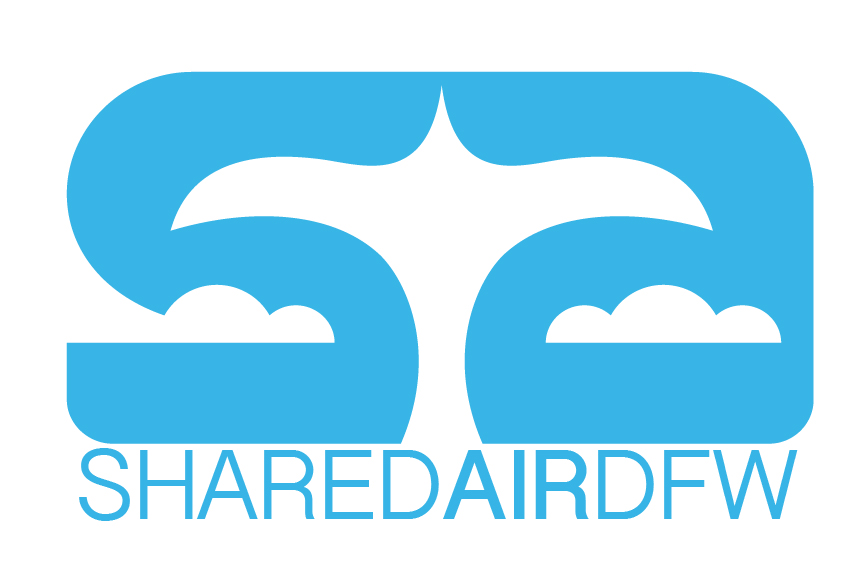 With its partners at UTD, Downwinders is building a new air monitoring network for DFW that will provide real time information from over 100 locations, including industrial hot spots in Joppa, West Dallas and Midlothian.
With its partners at UTD, Downwinders is building a new air monitoring network for DFW that will provide real time information from over 100 locations, including industrial hot spots in Joppa, West Dallas and Midlothian.
Why Do It?
Dallas County’s 2.7 million residents currently share only one EPA 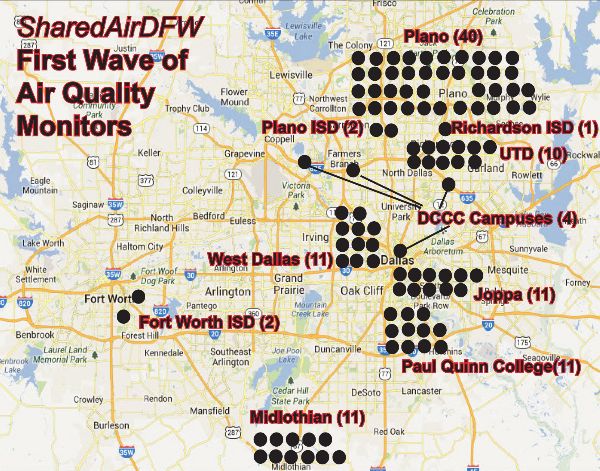 Particulate Matter air pollution monitor, north of downtown. Tarrant County has two and Denton County one. These monitors only reflect very local conditions and don’t reveal pollution levels in “frontline” neighborhoods where industry operates next to homes.
Particulate Matter air pollution monitor, north of downtown. Tarrant County has two and Denton County one. These monitors only reflect very local conditions and don’t reveal pollution levels in “frontline” neighborhoods where industry operates next to homes.
Making pollution burdens more equitable across racial and class lines requires identifying, measuring, and mapping those burdens: “You can’t fix what you don’t measure.” The SHAREDAIRDFW network is the first attempt to permanently map air pollution burdens across North Texas and make that information easily accessible to the public 24/7.Dallas County’s 2.7 million residents currently share only one EPA Particulate Matter air pollution monitor, north of downtown. Tarrant County has two and Denton County one. These monitors only reflect very local conditions and don’t reveal pollution levels in “frontline” neighborhoods where industry operates next to homes.
Making pollution burdens more equitable across racial and class lines requires identifying, measuring, and mapping those burdens: “You can’t fix what you don’t measure.” The SHAREDAIRDFW network is the first attempt to permanently map air pollution burdens across North Texas and make that information easily accessible to the public 24/7.
What’s the COVID Connection?
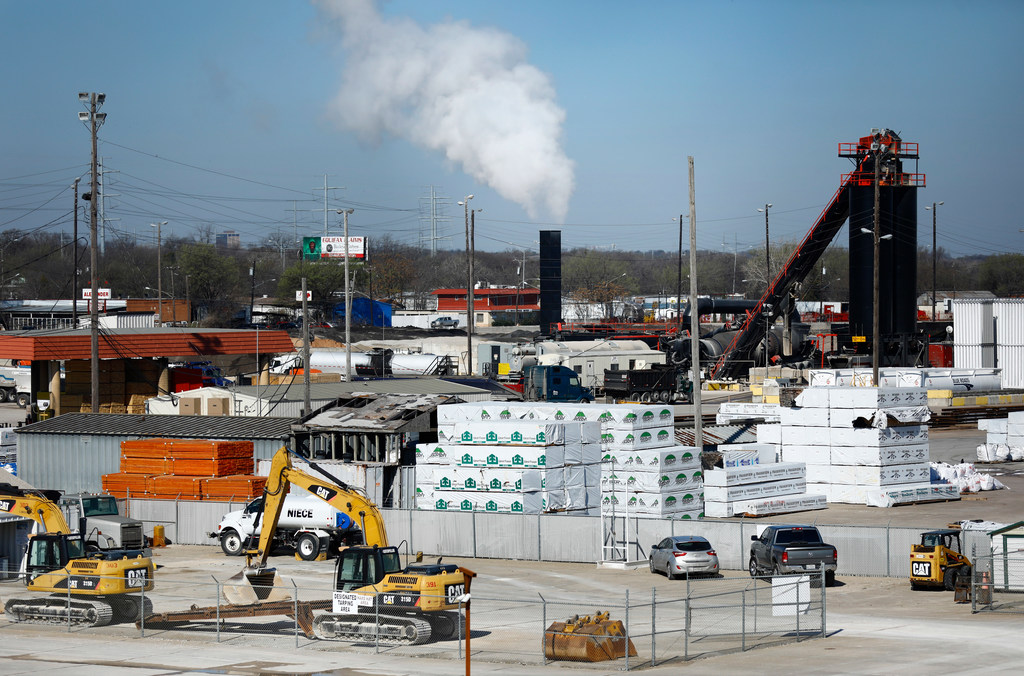
Research being done during the COVID pandemic concludes those living with the highest air pollution burdens are among the most vulnerable to being infected and dying from it. Specifically there seems to be a connection between a person’s exposure to Particulate Matter and Nitrogen Oxide air pollutants and the likelihood of contracting COVID. Past studies from the SARS epidemic also point to a strong link between exposure to air pollution and vulnerability to illness.By mapping where the heaviest air pollution burdens are, we can avoid adding to that burden and pursue policies targeting pollution decreases. We can begin to reverse the circumstances that makes the most pollution-impacted neighborhoods the most vulnerable to disease.
STATUS?
Via teleconferencing, UTD students are finishing up the digital map the Network 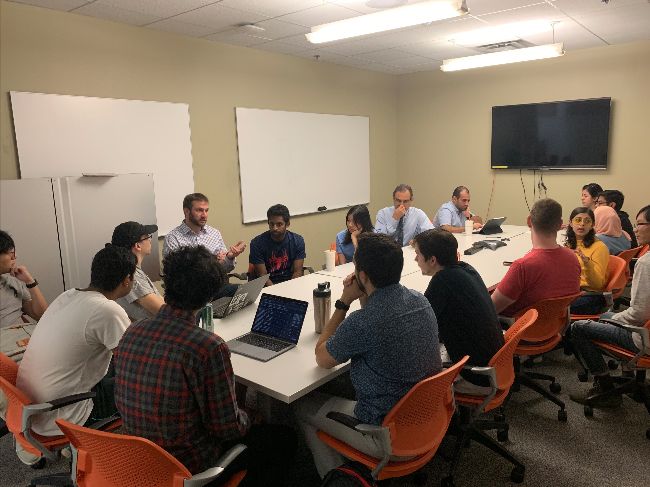 will use to display its real time air quality information. This map is meant to display not only the levels recorded by our own fleet of monitors, but easy access to the handful of EPA and Purple Air monitors in DFW as well.
will use to display its real time air quality information. This map is meant to display not only the levels recorded by our own fleet of monitors, but easy access to the handful of EPA and Purple Air monitors in DFW as well.
The map will be hosted on websites hosted by UTD, Dallas County and Downwinders.The first community monitors are slated for the former Freedman’s town of Joppa, where Downwinders bought a utility pole for the installation of the larger Mothership monitor. We’ve got a contract for Internet service and are now trying to tie down electrical power.
After a planned community meeting in March was canceled, we’re now gearing back up to find hosts for all ten “satellite” monitors. We hope to be able to begin operat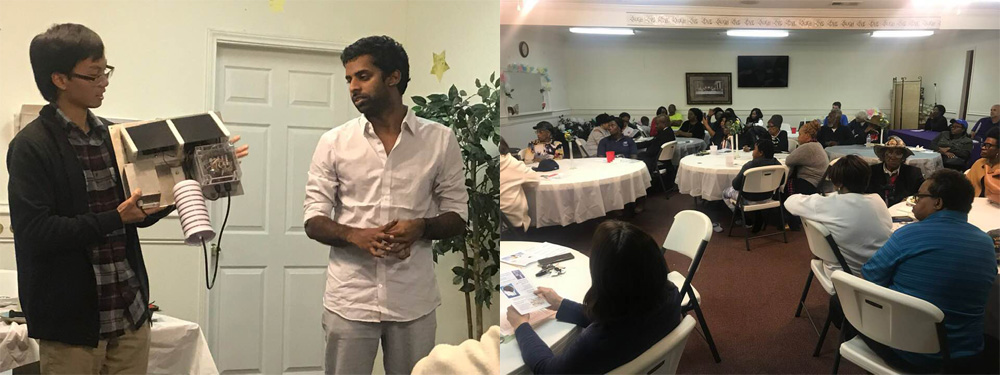 ion this summer.Once we’re up and running in Joppa, West Dallas is next and then Midlothian. In all Downwiwnders will be responsible for 33 of the over 100
ion this summer.Once we’re up and running in Joppa, West Dallas is next and then Midlothian. In all Downwiwnders will be responsible for 33 of the over 100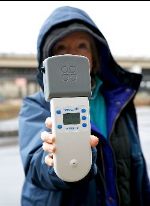 network monitors going up as part of the first wave installation.
network monitors going up as part of the first wave installation.
……MEANWHILE, Downwinders is using its portable monitors to record air quality in front line neighborhoods during the shelter-in-place periods so we’ll have a baseline for what cleaner air looks like.
Texas Misusing 17-Year Old Rural Air Pollution Model to Permit Inner-City Joppa Asphalt Plant
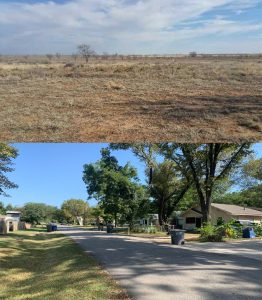
One of these is not like the other
What if you found out an industrial polluter was operating in your densely-populated neighborhood and the state told you not to worry because an obsolete computer model of the polluter’s releases 17 years ago and 500 miles away, in a desert, performed by the polluter themselves, said everything was OK?
That’s exactly the situation Joppa residents find themselves in as the Texas Commission on Environmental Quality (TCEQ) goes through the motions of renewing one of the permits of the many industrial polluters located in the community.
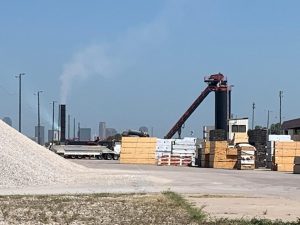 Austin Industries’ asphalt batch plant sits next to the Marietta Martin (TXI) concrete batch plant in Joppa, and both are in the Union Pacific switch yard and all of those are adjacent to the giant Tamko asphalt roofing factory.
Austin Industries’ asphalt batch plant sits next to the Marietta Martin (TXI) concrete batch plant in Joppa, and both are in the Union Pacific switch yard and all of those are adjacent to the giant Tamko asphalt roofing factory.
Austin has applied to the TCEQ for a renewal of its 10-year old air permit for its Joppa plant and gave notice last December. Legal Aid of NorthWest Texas requested a contested case hearing on behalf of the Joppa Freedman’s Town Association and Downwinders at Risk requested one on behalf of resident Jabrille McDuffie.
To absolutely no one’s surprise, TCEQ’s Executive Director recommended against such a hearing at the beginning of August in comments mailed out to all parities. He argued that contrary to the opponent’s claims there was sufficient evidence that Austin Industries permit in Joppa was following the law and was “protective of human health.” Previous “air quality analysis,” the Executive Director says, have concluded such already.
The entire basis of that “air quality analysis” is the computer air modeling performed by Austin Industries’ hired contractors and supposedly double-checked by the state…in 2002.
Just like any other computer model, it all depends on the variables: volume of air pollution, local meteorology, stack height, local “receptors” aka people or animals who live by or near the facility, and even local terrain. Winds do one thing to air pollution on the open plains and another in the middle of a city block.
Because of these variables, an Exxon refinery that wants to build a facility in Houston with the exact same design as is has in Arkansas still has to submit a separate computer model to account for the distinct surroundings in the new location. The one from Arkansas just won’t do for Houston.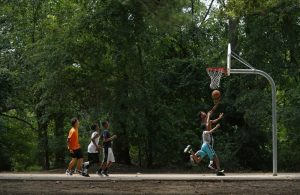
Or at least that’s the way things are supposed to work. But like so much else in Southern Dallas these days, things aren’t working the way they’re supposed to.
According to the TCEQ the Austin Asphalt facility is a portable asphalt batch plant operation. That means it wasn’t built specifically for its current Joppa site. It was moved there and it can be moved somewhere else.
In 2002 it first operated in Hockley County, a rural part of Northwest Texas near Lubbock some 400 miles west of Joppa. It moved to its current location in Joppa in 2008.
In 2002 the TCEQ let Austin Industries use what’s called a “SCREEN3” air model to determine if the air pollution from its asphalt batch plant’s was a threat to anyone in Hockley County. Again unsurprisingly, the firm hired by Austin Industries to do the computer modeling found it was “protective of human health.”
TCEQ says the Austin Industries’ asphalt plant has never been subject to any additional “impacts evaluation.” besides this 2002 review.
That means the only air modeling ever done for this Austin asphalt plant was while it was operating in rural Hockley County in 2002. There has been no air modeling of the plant since it came to Joppa in 2008.
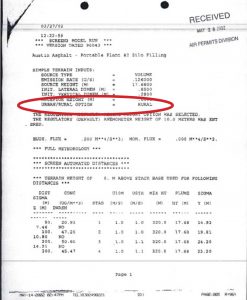
In 2002 the Austin plant was in West Texas and used a rural air model. In 2019 they’re still using for it for operation in Joppa.
Besides the most obvious and important difference in population density between unincorporated Hockley County near Lubbock and inner city Dallas, all of the variables in the 2002 modeling apply only to the Hockley County location. Meteorology, stack height, and surrounding terrain among them. In fact, the entire model was defaulted to a “rural” versus “urban” option in 2002. This renders the modeling scientifically useless in its current location in Joppa.
But that uselessness isn’t keeping the Executive Director of the Texas Commission on Environmental Quality from citing it to justify renewal of Austin’s air permit.
There’s also the matter of the age and limitations of the SCREEN3 model. In 2011 EPA replaced it with something called the “AERSCREEN” model. In doing so the agency called the old model “outdated“ and said “there are no valid reasons” to keep using SCREEN3.
And it’s not just the EPA. State environmental agencies, like the Arizona Department of Environmental Quality, have quit accepting SCREEN3 modeling.
Alex De Visscher, Associate Professor and Canada Research Chair in Air Quality and Pollution Control Engineering at the University of Calgary, writing in an 2013 text book entitled “Air Dispersion Modeling: Foundations and Applications,” said SCEEN3 is a “product of a previous generation of air dispersion modeling” and “is no longer a recommended model… it does not allow for multiple sources, and it does not include atmospheric chemistry or deposition.”
These exclusions are important. There are multiple sources of Particulate Matter 2.5 air pollution at Austin Industries’ plant in its Joppa location, including piles of raw material, and industrial combustion at the site. SCREEN 3 modeling didn’t and wouldn’t reflect these multiple sources of pollution. And of course when you’re talking about PM 2.5 pollution, as you are with an asphalt batch plant, the atmospheric chemistry and deposition, or fallout, is critical.
TCEQ’s own air modeling guidelines say so:
“Air dispersion models utilize dispersion coefficients to determine the rate of dispersion for a plume. Dispersion coefficients are influenced by factors such as land-use / land-cover (LULC), terrain, averaging period, and meteorological conditions. Evaluating the LULC within the modeling domain is an integral component to air dispersion modeling. The data obtained from a LULC analysis can be used to determine representative dispersion coefficients. The selection of representative dispersion coefficients may be as simple as selecting between rural or urban land-use types. For the ISC, ISC-PRIME, and SCREEN3 models, the dispersion coefficients are based on whether the area is predominately rural or urban. The classification of the land use in the vicinity of sources of air pollution is needed because dispersion rates differ between rural and urban areas.”
The TCEQ itself says it makes a fundamental difference whether the air model for a polluter is run for urban or rural terrain. Yet for over a decade TCEQ and Austin Asphalt have misused the results of a “rural” computer model to misleadingly assure inner-city Joppa residents that the company’s asphalt plant posed no harm.
What’s more, the modeling performed in 2002 only examined “asphalt vapors,” a made-up, vague pollutant category that can’t be monitored or measured. It didn’t examine Particulate Matter 2.5 pollution or specific Volatile Organic Compounds that make up those “vapors” and was therefore incomplete in the extreme.
So despite all the verbage the TCEQ’s Executive Director uses to tell Joppa residents th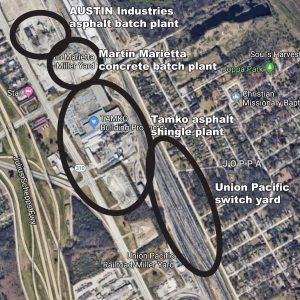 at past “air analysis” has shown Austin Industries’ plant to be protective of human health, in truth the only “analysis” ever done was performed 17 years ago in a sparsely-populated rural location 400 miles away from its current location, with what TCEQ admits are totally inaccurate modeling inputs by company consultants. It didn’t include all priority pollutants or even all sources of air pollution from the facility and the model used is now considered obsolete by EPA, modeling experts, and other state environmental agencies.
at past “air analysis” has shown Austin Industries’ plant to be protective of human health, in truth the only “analysis” ever done was performed 17 years ago in a sparsely-populated rural location 400 miles away from its current location, with what TCEQ admits are totally inaccurate modeling inputs by company consultants. It didn’t include all priority pollutants or even all sources of air pollution from the facility and the model used is now considered obsolete by EPA, modeling experts, and other state environmental agencies.
Joppa residents deserve better.
In its response to the Executive Director, Downwinders at Risk specifically requested TCEQ delay further regulatory action on this permit renewal until it can conduct a modern comprehensive air modeling impact analysis for Austin Asphalt’s current operation in Joppa that requires an evaluation of all on-site sources of pollution, including fugitive and mobile sources, on the Austin Asphalt site, off-site near-by sources of pollution within a three kilometer (1.86 mile) radius of Austin Asphalt’s facility, and representative monitored background concentrations obtained from local Joppa neighborhood monitoring as well as modeling of permitted maximums emission rates form all sources.
On September 11th the Texas Commission on Environmental Quality will take up the Austin Industries permit renewal at its headquarters in Austin. Both Legal Aid and Downwinders at Risk representatives will be present to answer any questions from the Commissioners but will not be allowed to make any statements. We’ll let you know the outcome.
One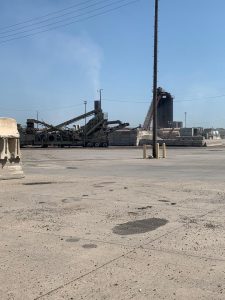 might reasonably ask why the City of Dallas itself isn’t fighting this permit renewal? After all in 2007, the city took on a string of proposed coal-fired power plants that it said would increase air pollution for Dallas. But to date that same city has never bothered to try and stop an industrial polluter from opening shop or renewing its permit in one of its most abused neighborhoods.
might reasonably ask why the City of Dallas itself isn’t fighting this permit renewal? After all in 2007, the city took on a string of proposed coal-fired power plants that it said would increase air pollution for Dallas. But to date that same city has never bothered to try and stop an industrial polluter from opening shop or renewing its permit in one of its most abused neighborhoods.
This dishonest use of a irrelevant model by the state’s discredited environmental agency shows why it’s imperative the City of Dallas – and all municipalities in Texas – change the way they do business and be proactive in addressing their environmental justice and environmental health issues in their own city limits.
Too often city representatives default to state or federal officials on the environment when they should be the first line of defense, not the last. City officials’ reliance on a failed state agency to perform its job as environmental protector is what caused Shingle Mountain. It’s what caused this situation in Joppa. To change that means changing both policies coming out of City Hall and current City Hall culture. Environmental Protection is a Do-It-Yourself proposition these days.
Sorry Ms. Jackson: The City is Failing Southern Dallas
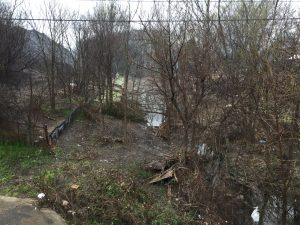
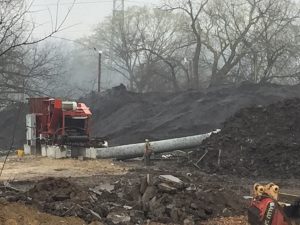
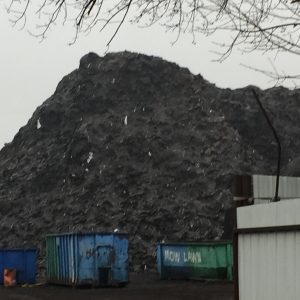
Marsha Jackson thought she’d found relief when Dallas Morning News columnist Robert Wilonsky wrote about the grotesque environmental disaster being caused by the Blue Star asphalt operation in mid-December..the first time.
After complaining almost a year to the City of Dallas, the State of Texas, and the EPA without any action taken, Ms Jackson saw Wilsonky’s column set-off a flurry of official concern about this inept and dangerous operation destroying acres of tree-covered Southern Dallas and Ms. Jackson’s home of 25 years.
That’ll happen when the city’s most read reporter informs you for the first time in passing about a situation it’s your job to already know about.
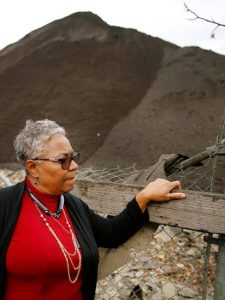 But that initial knee-jerk response left Blue Star still open for business, and without a clean-up. So Wilonsky wrote another column. Some more official action ensued. The City got a Temporary Restraining Order….that expired after a week. The authorities made Blue Star push their 4-5 story high mountains of used shingles back away from a small creek running through it’s property so the waterway would be better protected. Ms. Jackson? Not so much.
But that initial knee-jerk response left Blue Star still open for business, and without a clean-up. So Wilonsky wrote another column. Some more official action ensued. The City got a Temporary Restraining Order….that expired after a week. The authorities made Blue Star push their 4-5 story high mountains of used shingles back away from a small creek running through it’s property so the waterway would be better protected. Ms. Jackson? Not so much.
In fact, Blue Star has not been cited with even one nuisance, air pollution, or public health violation by the City of Dallas since it began building its special version of Hell a little more than a year ago. Officially, the city has shown zero concern for the human toll being taken by Blue Star’s pollution.
Last month Wilsosky wrote his third column stating what many of us feel when we see the operation in person: “This is insane.” He got Dallas City Manager T.C. Broadnax on the record saying Ms. Jackson’s plight was the result of bad zoning, the kind that allows polluters to only set-up shop south of Dallas’ historic dividing line Trinity River. But no action was taken to change that zoning and Blue Star keeps right on accepting truckloads of old shingles and keeps grinding them up in the open-air using the industrial equivalent of giant wood chippers, spewing fiberglass, plastic and maybe asbestos into Ms. Jackson’s property and neighborhood.
Blue Star keeps operating even though the City of Dallas says the business didn’t have a Certificate of Occupancy when they opened, despite evidence current city zoning doesn’t allow what they’re doing on the property they’re doing it on, and despite evidence they don’t have all the environmental paperwork they need for the despoiling taking place.
Despite his best efforts to do the job the City and State are supposed to be doing, Wilonsky’s words just haven’t been enough to stop the obscene environmental and public health problems being caused daily by Blue Star.
So maybe it’s time to do this ourselves.
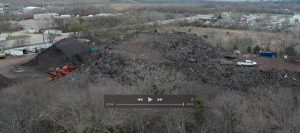
Maybe it’s time to file some lawsuits of our own, as citizens. There’s now plenty of documentation to prove the case of destruction, property rights takings, and personal and public health problems. Are there lawyers working in the public interest who could pursue these on behalf of Ms. Jackson and her neighbors? Yes there are. There are ones who can sue for regulatory relief and others who sue for “personal damages” caused by this kind of reckless disregard. These “toxic tort” attorneys would do well to target the deep pockets of the City of Dallas and the State of Texas as well as the modest holdings of Blue Star. Often the way to permanently put a stop to this kind of thing is to make the responsible parities pay such a high price that they’re never even tempted to try it again.
Maybe it’s time for us to begin amortization proceedings against Blue Star. This is the process that closed the RSR lead smelter in West Dallas in the 1980’s. A city can change the zoning for a piece of property to something that clearly does not allow the current activity to take place on that property. In order to be fair, the law allows the current users to operate until they get their investment in the property back and then they have to close-shop and move. Once you see the Blue Star property, you’ll understand that it’ll take about a day and a half for the company to get back its “investment.” In fact, because of all the violations of law and probable lawsuits, Blue Star is probably already close to being in the red.
Amortization proceedings can be initiated by the City Council OR citizens themselves. Here’s a description from the Dallas City Code using the City’s 15-member, council-appointed Board of Adjustments:
§ 51A-4.704. Nonconforming Uses And Structures.
The city council may request that the board of adjustment consider establishing a compliance date for a nonconforming use. In addition, any person who resides or owns real property in the city may request that the board consider establishing a compliance date for a nonconforming use. Upon receiving such a request, the board shall hold a public hearing to determine whether continued operation of the nonconforming use will have an adverse effect on nearby properties. If, based on the evidence presented at the public hearing, the board determines that continued operation of the use will have an adverse effect on nearby properties, it shall proceed to establish a compliance date for the nonconforming use; otherwise, it shall not.
Ms. Jackson owns her house. So maybe it’s time we help her petition the Board of Adjustments to begin kicking Blue Star out of Southern Dallas ourselves. If the Council wants to do its job and join in, that w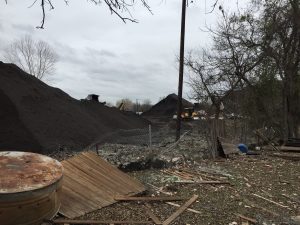 ould be great. But we don’t need them to start the ball rolling.
ould be great. But we don’t need them to start the ball rolling.
Maybe it’s time we protested. Not just on behalf of Ms. Jackson, but the ancient, racist underlying cause of this awful situation and so many more south of the Trinity River. Everyone who lives in the “Southern Sector” is a current or potential Marsha Jackson. We’ve got to begin to change the entire zoning map of the city to get rid of the kind of outrages even the City Manager acknowledges are a problem. We need to demonstrate not just against Blue Star, but for improvement across the board, for real progress on the City’s own Master Plan for South Central that aims to “de-industrialize” the area – not make it into a wasteland. We need a platform for progress that address the Southern Sector as a whole instead of continuing to play whack-a-polluter every few months at a different location.
Since August, T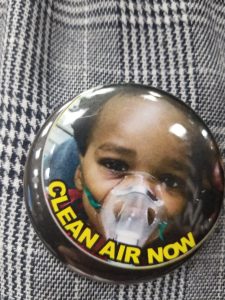 he Let Joppa Breathe Alliance has been meeting to try and draft such a platform as part of its mission. It’s been recruiting allies south and north of the river. It’s very near to making an announcement about that platform and the means it will begin to pursue it. This platform will be the first attempt to articulate specific City of Dallas environmental justice policy changes in the City’s history. It represents a tectonic shift in responding to age-old discrimination that’s still leaving a huge dusty coal-like legacy in Southern Dallas. We’re tired of playing defense. Its time we set the agenda.
he Let Joppa Breathe Alliance has been meeting to try and draft such a platform as part of its mission. It’s been recruiting allies south and north of the river. It’s very near to making an announcement about that platform and the means it will begin to pursue it. This platform will be the first attempt to articulate specific City of Dallas environmental justice policy changes in the City’s history. It represents a tectonic shift in responding to age-old discrimination that’s still leaving a huge dusty coal-like legacy in Southern Dallas. We’re tired of playing defense. Its time we set the agenda.
Dallas City Hall has failed Ms. Jackson and her neighbors. It’s failed Joppa. It’s failed Cadillac Heights, and Highland Hills and Fruitdale, and West Dallas. Over and over again. To win progress, something more must be done. When the call comes for that something more, how will you respond?
Council Member (& Dallas Mayoral Candidate?) Scott Griggs is 1-Day University of Change Lunch Speaker
 If a full day of informative workshops by experts, networking with other local activists and organizers, plus lunch wasn’t enough to get you interested in coming to our 1-Day University of Change on Saturday December 8th, what about a mid-day briefing from long-tine Oak Cliff Council Member Scott Griggs on the importance of the upcoming May municipal elections – an election that may see him running for Mayor of Dallas?
If a full day of informative workshops by experts, networking with other local activists and organizers, plus lunch wasn’t enough to get you interested in coming to our 1-Day University of Change on Saturday December 8th, what about a mid-day briefing from long-tine Oak Cliff Council Member Scott Griggs on the importance of the upcoming May municipal elections – an election that may see him running for Mayor of Dallas?
Griggs is associated with “good government” initiatives making City Hall more transparent and accountable, but he’s also been a forceful advocate for New Urbanism “green government.”
Although widely remembered as a critic of the now-dead Trinity Toll Road, Griggs was first elected in 2011 with quite a bit of help from Dallas gas drilling opponents.
Seven years ago the Barnett Shale was still hopping and every local government was trying to cash in without concerns of any downside. Fights over drilling restrictions in Fort Worth, Southlake, and Grapevine had preceded the Dallas battle and industry wanted to impose the “Fort Worth model” of unchallenging drilling provisions on Dallas.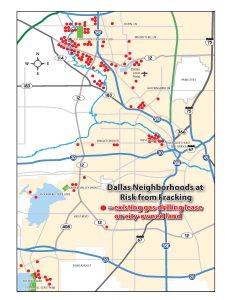
In 2011, nobody had yet discovered the secret agreement between then City Manager Mary Suhm and Driller Trinity East that gave permission to do all kinds of things not allowed by the city at the time – like drilling in floodplains and parks. City staff was going out of its way to shepherd drilling permits for the company through the bureaucracy even as citizen opposition convinced other drillers like Exxon to pull out of Dallas. Nobody could figure out why until the secret agreement was leaked to the Dallas Observer. There’s no direct evidence of who released the agreement, but speculation centered on Griggs, and then-city council member Angela Hunt.
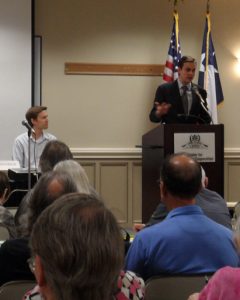
CM Scott Griggs addressing citizen Town Hall on gas drilling in 2012
From that point forward citizens begin winning more votes at the Planning Commission and Council. First to go was the favoritism staff had shown the proposed Trinity East drilling permits. They were defeated outright and resulted in a lawsuit filed by the company still in the courts over who promised to do what for whom. In the wake of their demise, the most protective gas drilling ordinance then proposed for any Texas city was passed by the Dallas Council. It established a more restrictive “Dallas model” to counterbalance the more lenient Fort Worth one.
If the only major accomplishments of Griggs city council years was killing the Zombie Toll Road and saving Dallas from irresponsible gas drilling, he’d have earned his pay. But those are only two of the many battles Griggs has fought with City Staff and his more establishment-oriented colleagues. The recent historic change in the city’s housing policy was fueled by his reforms. For the first time the City has made it policy not to keep concentrating subsidized housing in South Dallas areas which already have more than their fair share amidst high rates of poverty and lack of employment opportunities.
He’s one of a handful of council members who’s made it their business to take on entrenched city staff  time and again over issues of responsiveness and common sense. Even though he sits on the other side of the horseshoe, he has the healthy skepticism of a citizen still fighting City Hall.
time and again over issues of responsiveness and common sense. Even though he sits on the other side of the horseshoe, he has the healthy skepticism of a citizen still fighting City Hall.
We’re not the only ones who hold a high opinion of Griggs. D magazine names him “Best Politician” in 2012 and Best Public Official 2016. the Dallas Observer named him Best Politician (2012) and Best Council Member (2013, 2015). The venerable Oak Cliff Conservation League gave him their Oak Cliff Warrior Award in 2015.
 Griggs terms-out as of this coming May and speculation is running high that he’s preparing to run for Mayor. If he wins there’s no doubt he would be the most progressive mayor for Big D since Laura Miller ten years ago. Depending on who takes his place and what other candidates win, Dallas could end up with an 8-vote solid voting progressive/green majority for Griggs. That promise of a truly reform-minded council is what’s motivating a new wave of anticipation for the municipal elections, especially after a very successful November in Dallas County as a whole.
Griggs terms-out as of this coming May and speculation is running high that he’s preparing to run for Mayor. If he wins there’s no doubt he would be the most progressive mayor for Big D since Laura Miller ten years ago. Depending on who takes his place and what other candidates win, Dallas could end up with an 8-vote solid voting progressive/green majority for Griggs. That promise of a truly reform-minded council is what’s motivating a new wave of anticipation for the municipal elections, especially after a very successful November in Dallas County as a whole.
Downwinders is proud to host the lunch time briefing from Council Member Griggs. Just as progressives used the recent mid-terms as a way to build a bluer Congress and State House, locals will be seeking to use the May Dallas elections to seat the most environmentally friendly city council it’s ever known.
Local governments are becoming the launching pads for change as state and federal agencies retreat or surrender their basic quality of life responsibilities. Having a progressive majority in Dallas that could join this effort would be a huge jump start for all kinds of good things to happen.
If Griggs decides to run (the window for filing to run in May begins January 16th) 1-Day University participants could get a sneak peak at the kind of vision he’ll be promoting for the city, maybe a trail run at a stump speech. For Dallas environmentalists, the May elections may actually begin at lunch on December 8th. Make sure you’re there.
Sign up for the 1-Day University here, or pay at the door.
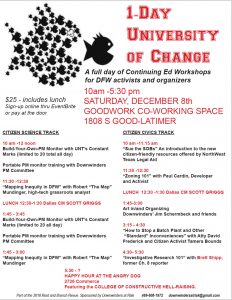
Announcing Downwinders 3.0

Downwinders is Regrouping, Renewing, and Regenerating. Almost half our new board is under 30. We have a new scientist. We have a new focus. Now we need you.
Many of you are aware of the time and effort Downwinders at Risk put into the unprecedented UNT Ozone Study which brought DFW elected officials and local atmospheric researchers together for the first time to operate the same computer model for air quality used exclusively by the State and EPA.
The results of that study provided a practical map for compliance with the current federal ozone standard: new controls on coal plants, cement kilns and gas facilities. It was shared by local officials with the EPA in hopes of that agency drafting a new DFW air plan that might finally address these major sources of local air pollution.
Those hopes were dashed by the presidential election last fall.
Because of a perfect storm of regulatory changes and politics, we now believe that the EPA won’t intervene on behalf of DFW air quality for the foreseeable future. It appears DFW will not even have to submit another serious plan to address smog for at least a decade – if then.
Over the last 20 years no other group has leveraged as much change from DFW federal clean air plans as Downwinders at Risk. We won the first comprehensive study of cement plant air pollution control technology by the state. We got new smog-control technology installed on the Midlothian cement plants. We used the “Green Cement” provision of another federal smog plan to stop the burning of hazardous waste in those cement plants and close the oldest, dirtest kilns in North Texas. In the most recent plan, we exposed the large impact of oil and gas pollution on local DFW smog levels.
But while we’ll continue to stay in the EPA’s ozone/smog regulatory loop through legal representation, we don’t see any opportunity to impact public policy using federal clean air plans the way we have in the past.
With this change, we had to rethink how we work toward better regional air quality in North Texas. How do we impact the most lives, in the biggest ways, with the resources we have?
We’ve come up with three strategies, all of them taking advantage of our long history of increasing the ability of local residents and governments to take on dirty air themselves.
____________________________________________
OUR NEW PRIORITIES
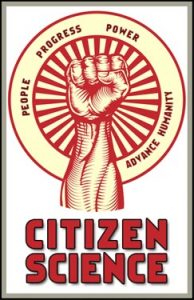
Build a modern, independent, and citizen-friendly regional air pollution monitoring network for DFW
You can’t fix problems unless you know about them, and this is a way to begin building a regional alternative to state monopoly of air quality expertise and resources.
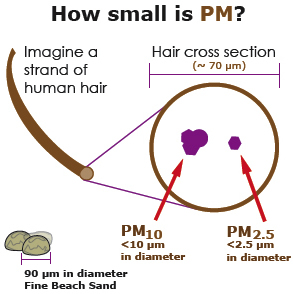
Identify, reduce, and eliminate health threats posed by widespread Particulate Matter (PM)pollution in DFW
PM is the new smog and local campaigns to reduce it can help a lot of people, especially those predominantly minority neighborhoods who’ve been dumped on the most.
Organize a grassroots campaign to restore local government zoning control of industrial hazards
A state government bought by polluters has gone too far in restricting the liberties of Texans and demolishing democracy at the local level. We’re fighting back.
____________________________________________
We co-founded the DFW Air Research Consortium last year with researchers from area universities and local governments with the idea of building a modern and locally-controlled air quality monitoring grid across DFW that can track pollution plumes in real time. This can become a powerful grassroots enforcement and education tool.
Downwinders itself bought two EPA-certified ozone monitors we’ll be using to specifically track smog levels in Wise County, where the State refuses to put a monitor despite evidence that’s where the region’s highest ozone readings are located.
This is more than just increasing the number of monitors – this is an opportunity to change the way people see air pollution affecting their lives. It’s also another opportunity to take what was the exclusive regulatory providence of an apathetic state government and give it to more concerned local governments.
We’re also beginning a new campaign focusing on microscopic pieces of soot known as Particulate Matter, or PM pollution. In recent years, PM pollution has been linked in the scientific literature to a wide variety of non-respiratory and cardiovascular diseases including ADHD, autism, Parkinson’s, dementia, and infertility. Like lead, many researchers believe there is no safe level of exposure to this kind of pollution.
Sources of PM pollution include any internal combustion engine, furnace, boiler and windswept piles of sand, or cement dust. Studies have found a correlation between proximity to a major source of PM pollution and increased risks of illness.
This is why other communities around the country are cracking down on idling trucks and buses and establishing buffer zones between major freeways and residences, parks and schools. We want to reduce the pollution as well as the exposure to it.
Finally, because there’s no hope of addressing air pollution from the oil and gas industry without any change in HB 40, the 2015 state law that took away local control of industrial zoning, we’ve begun a project aimed at building an alliance that challenges state overreach and promotes the restoration of traditional local control. Cities must have the right to protect their residents’ public safety and health. This campaign will challenge the status quo in both Austin and North Texas.
As always, they’ll also be campaigns we could not anticipate but have to wage. One example is the recent proposal by Dow Chemical to bag municipal trash for burning in the nation’s cement kilns. Dow has already targeted the local cement kilns in North Texas for this scheme, but Downwinders is pushing back hard and working with nationwide alliances to halt this project before it gets very far.
NOW WE NEED YOU

This coming THURSDAY is another North Texas Giving Day, a chance for your donations to be magnified by challenge grants and other incentives over the day. Because we’ve added responsibilities and staff, Downwinders at Risk needs this one to be our best, most productive Giving Day yet.
All transactions take place online that day. It’s simple to give and you can link to the Giving Day pay portal through our Downwinders’ website or FaceBook page beginning at 6 am on the 14th, and going all the way to midnight:
https://northtexasgivingday.org/npo/downwinders-at-risk-education-fund
DFW has been in continuous violation of the Clean Air Act for 26 years. We’re asking you to take a minute and contribute $26 to clean air work in the place where your lungs do most of their breathing.
We know hurricane season is testing the limits of our charitable giving, but $26 is all we’re asking. At a time when the state and federal government are intent on not protecting our air, Downwinders continues to be stubborn advocates for progress.
We deeply regret not being able to win a clean air plan for DFW in 2017 that might finally leave us in compliance with the Clean Air Act. But our long term goals remain the same. We hope you agree our work is worth your continued support. Thank you for your consideration.


